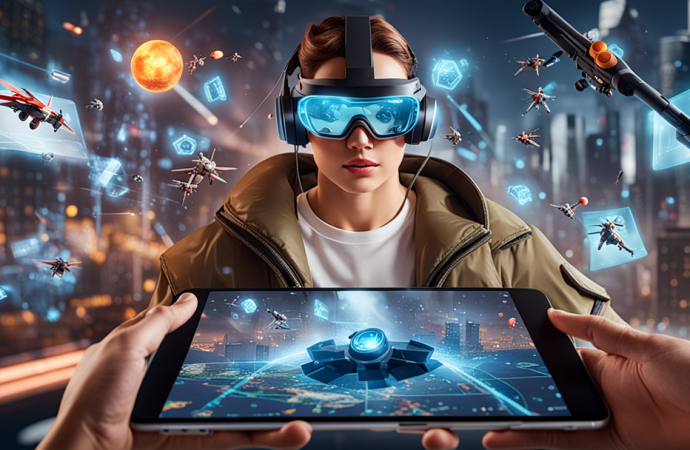Introduction Augmented Reality (AR) is rapidly transforming the landscape of the gaming industry, offering players immersive experiences that blend the real world with digital elements. This technological advancement is not just a fleeting trend; it is a significant shift that promises to redefine how we interact with games and the environments around us. This article
Introduction
Augmented Reality (AR) is rapidly transforming the landscape of the gaming industry, offering players immersive experiences that blend the real world with digital elements. This technological advancement is not just a fleeting trend; it is a significant shift that promises to redefine how we interact with games and the environments around us. This article delves into the various aspects of Augmented Reality Gaming, exploring its impact, applications, and future potential.
What is Augmented Reality?

Image by: Google.com
Augmented Reality (AR) is a technology that overlays digital information such as images, sounds, and other data onto the real world, enhancing the user’s perception and interaction with their environment. Unlike Virtual Reality (VR), which creates a completely artificial environment, AR maintains the real world setting and enriches it with digital features.
The Evolution of Augmented Reality in Gaming
- Early Beginnings
The concept of AR has been around for several decades, but it was not until the advent of smartphones and advanced computing technologies that it became feasible for mainstream use. Early examples of AR in gaming include simple mobile apps that used the phone’s camera to overlay basic graphics onto the real world.
- Technological Advancements
With the development of more sophisticated sensors, cameras, and processing power, AR gaming has evolved significantly. Devices like AR glasses and headsets, coupled with powerful software, have made it possible to create highly interactive and realistic gaming experiences.
Key Components of Augmented Reality Gaming

Image by: Google.com
- Hardware
Smartphones and Tablets: Most AR games are currently played on mobile devices, which come equipped with cameras, GPS, and accelerometers.
AR Glasses and Headsets: Devices like Microsoft Holo Lens and Magic Leap offer more immersive experiences by providing a hands free interface and more advanced sensors.
Wearables: Some AR games incorporate wearables like smartwatches or fitness trackers to enhance gameplay.
- Software
AR Platforms: Software development kits (SDKs) like ARKit (Apple) and AR Core (Google) provide the tools needed to create AR experiences.
Game Engines: Engines like Unity and Unreal Engine have integrated AR capabilities, making it easier for developers to create complex AR games.
- User Interface
Gesture Control: Players can interact with AR games using hand gestures, providing a more intuitive and immersive experience.
Voice Commands: Some AR games incorporate voice recognition, allowing players to control the game using spoken commands.
Popular Augmented Reality Games

Image by: Google.com
- Pokémon GO
Released in 2016 by Niantic, Pokémon GO was a groundbreaking AR game that took the world by storm. Players use their smartphones to find and capture virtual Pokémon in real world locations. The game uses GPS to track the player’s location and camera to overlay Pokémon onto the real world.
- Ingress
Another popular AR game by Niantic, Ingress involves players capturing “portals” located at real world landmarks. The game encourages exploration and social interaction, as players must physically visit these locations to participate.
- Harry Potter: Wizards Unite
Building on the success of Pokémon GO, Niantic released Harry Potter: Wizards Unite, an AR game that allows players to explore the magical world of Harry Potter in their own neighbor hoods. The game involves casting spells, finding magical artifacts, and interacting with iconic characters from the series.
The Impact of Augmented Reality on Gaming

Image by: Google.com
- Enhanced Immersion
AR games provide a level of immersion that traditional games cannot match. By integrating digital elements into the real world, players feel more connected to the game and their surroundings.
- Social Interaction
Many AR games encourage social interaction by requiring players to visit real world locations and collaborate with others. This fosters a sense of community and can lead to lasting friendships.
- Physical Activity
Unlike traditional video games that are played sitting down, many AR games require physical movement. This can have positive health benefits, as players are encouraged to walk, explore, and stay active.
- Educational Value
AR games can also have educational applications. For example, games that involve historical landmarks can teach players about history and geography in a fun and engaging way.
Challenges and Limitations
- Technical Limitations
Battery Life: AR games can be demanding on device batteries, limiting playtime.
Hardware Requirements: Not all devices are capable of running advanced AR games, which can limit accessibility.
Data Privacy: AR games often require access to location data and cameras, raising concerns about privacy and data security. - Social and Ethical Concerns
Safety: Players engrossed in AR games may become unaware of their surroundings, leading to accidents.
Addiction: The immersive nature of AR games can make them highly addictive, potentially leading to negative impacts on mental health.
The Future of Augmented Reality Gaming

Image by: Google.com
- Technological Innovations
5G Connectivity: The rollout of 5G networks will enable faster and more reliable data transmission, enhancing the performance of AR games.
AI Integration: Artificial Intelligence can be used to create more adaptive and responsive AR experiences.
Advanced Wearables: Future AR glasses and headsets will likely become more lightweight, affordable, and feature rich. - New Genres and Experiences
Augmented Reality Sports: Imagine playing a game of virtual soccer in your backyard, with digital players and goals overlaid onto the real world.
Interactive Storytelling: AR can be used to create interactive narratives where players influence the story by interacting with their environment. - Broader Applications
Education: AR games can be used as educational tools, making learning more interactive and engaging.
Healthcare: AR gaming can be used for physical therapy and rehabilitation, providing a fun way to perform exercises.
Conclusion
Augmented Reality Gaming is revolutionizing the gaming industry by offering immersive, interactive, and engaging experiences that blend the digital and real worlds. While there are challenges to overcome, the future of AR gaming looks incredibly promising, with endless possibilities for innovation and growth. As technology continues to advance, we can expect AR games to become even more integrated into our daily lives, changing the way we play, learn, and interact with the world around us.
















